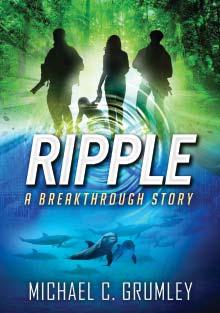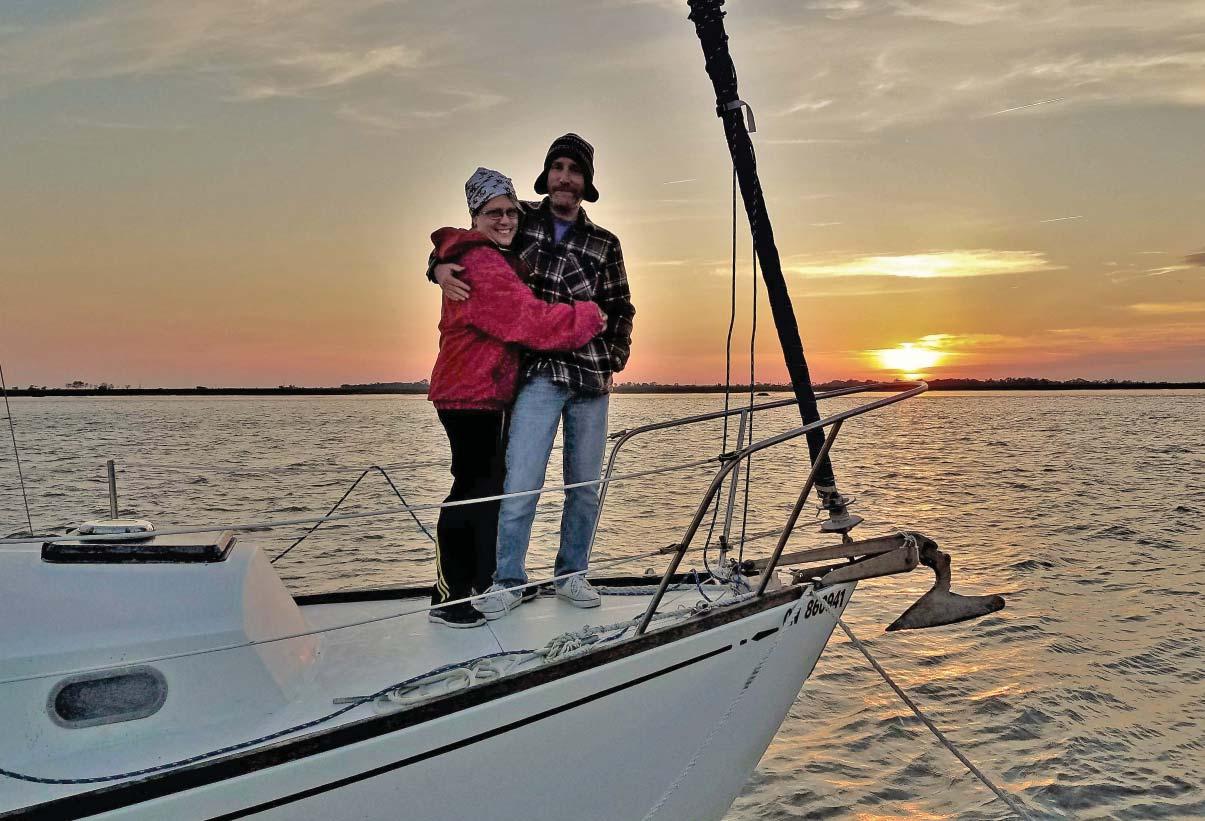
15 minute read
Sailing for a Dream
I met Kenny and Rhonda Thayer many years ago, when I lived near Atlanta and Kenny and I worked together. That was right around the time I bought my fi rst sailboat. In our downtimes at work, Kenny and I had many discussions about the philosophies of life and the world at large. He was one of the few people who understood my “crazy notion to buy a boat.” So I wasn’t all that surprised last year when Rhonda got in touch and told me they were in the market for a sailboat to do some traveling on as well. This is their story.
By Amy Thurman Photos provided by Kenny & Rhonda Thayer
Advertisement
While on vacation in Hawaii in 2013, Kenny and Rhonda Thayer, of Jonesboro, Ga., booked a sunset cruise on a catamaran. As they walked down the dock, they read the names and home ports of boats, marveling at the faraway places. They ended up going on several sunset cruises and one evening, Kenny struck up a conversation with one of the boat owners on the dock.
“You sailed that here from Washington State?” Kenny asked. The owner confi rmed that he had and at that moment, unbeknownst to Rhonda, an idea began to bloom and a dream was born. "I want to do that," Kenny thought.
When they returned home from their vacation, Kenny got online and started reading to develop an understanding of how people managed to travel all over the world on boats. He read stories from Lin and Larry Pardey, well-known in the cruising community, James Baldwin, who twice circumnavigated on a 28foot Pearson Triton sailboat, Sterling Hayden, who walked away from his Hollywood acting career in the 60s and went sailing, and Annie Hill, an English author of multiple books and articles about sailboat voyaging.
When he wasn’t reading about the possibilities, he was visiting websites listing boats for sale. He determined early on that a sailboat was the best option fi nancially as the boats were more aff ordable and would require less overhead in fuel costs.
His next step was to convince Rhonda. He’d shared some of the articles with her and she was intrigued, but reserved.
“I refused to get excited until I knew for sure he was going to follow through with it, or if this too would pass.” She had reservations. Kenny had come up with great plans in the past, but would lose interest in them. "Usually right about the time I got excited about them," she said. "But as the months went by, his excitement continued to grow as he moved forward with his planning. I fi nally realized he was serious this time. It was actually safe to get excited, so I jumped aboard with all the plan-making too!"
Rhonda had been recently diagnosed with Multiple Sclerosis and lost her job, but they were still determined to explore the possibilities.
The next step was to fi nd a boat – if they were able to do that, then they’d fi gure out the logistics. Kenny continued looking
online, evaluating sizes, engines and other features.
“Start with what you need – refrigeration, a toilet – and work from there,” Kenny said of the search process. He’d hoped to fi nd a Pearson Triton, like James Baldwin had sailed, or an Alberg, which is a stable oceanworthy sailboat, but was unsuccessful fi nding one in their price range or near enough to be feasible to purchase.
After driving to the coast on weekends to look at several diff erent boats, they fi nally settled on a Bristol 29.9. The 1978 fi n keel sloop was in good shape. The original owners, who had the boat built, never took it out sailing before selling it to an Australian couple. The second owners could only spend three months at a time aboard due to visa requirements, so the boat had very little wear and tear and had been reasonably maintained over the years. It had a small galley, was roomy enough inside for the two of them, and included a dinghy with a working outboard motor.
“It wasn’t exactly what I wanted, but we’re not going to be sailing around the world, and we can add other things we want, so it met our needs,” Kenny said.
So, last April, they signed the papers and became boat owners. Then it was time to start planning.
Their list of tasks to complete wasn’t lengthy but did have a bit of a learning curve and some challenges along the way, such as a leaky stuffi ng box, an overfi lled water tank, and fi guring out how to pattern the bimini canvas.
“Doing that on a windy day will test your marriage!” said Kenny, of plastic pattern material fl ying everywhere while the two of them tried to keep it in place for measurements. But clearly their marriage survived! Kenny, who isn’t fond of heights, had to go up the mast to install lines for the Lazy Jack system on the main sail. Strapped into the bosun’s chair and secured with two lines, he put his fear aside and stepped up to the job. Geoff Bandelier, their neighbor and mentor who’s been sailing for years, helped Rhonda work the lines to raise Kenny up and keep him secure while he worked. The height, along with the swaying motion of the mast, made for less than ideal working conditions from his perspective! His trip down the mast, when the two lines slipped out of sync causing pressure on an inconvenient part of his body, was even less pleasant. Future trips up the mast will be made by Rhonda. During the past year, on weekend trips to Jekyll Island where the boat is docked, they’ve steadily accomplished the tasks on their ever-growing list of things to do. They installed a new stove, replaced the running rigging, and refi nished some of the teak. They also built the bimini frame and even after the windy day of patternmaking, the sunbrella top fi t perfectly when Rhonda fi nished it. With the topsides nearly complete, next up is the bottom.
This month, Kenny and Rhonda will take the boat south to St. Marys Boat Services and have it hauled out. While the boat is on the hard, they’ll replace thru-hulls and repaint the bottom, and fi nish a few topside tasks, such as rebuilding a winch, some additional rigging repairs, fabricating a dodger and fi nish installing the Lazy Jack. When that’s done, they plan to return to Jekyll and spend a couple months doing some coastal sailing.
Although they’ve taken sailing lessons, they’re not yet comfortable setting out on their own and want to gain as much experience as possible in familiar waters before heading further afi eld. Their neighbor Geoff and his wife Linda have been
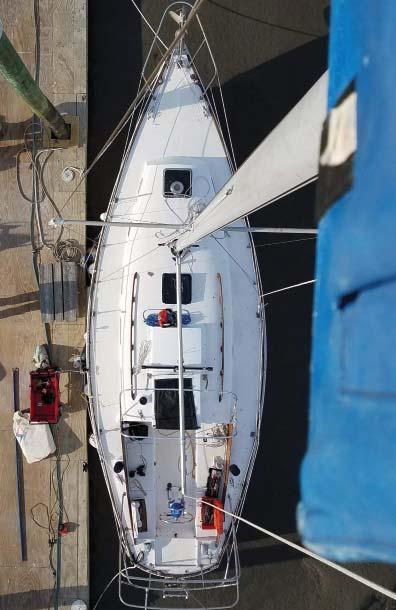
Opposite Page: Kenny and Rhonda Thayer on the bow of Questor at sunset. Above: View from the mast. Below: Main cabin of the boat looking aft at the galley (left) and forward toward the V-berth.
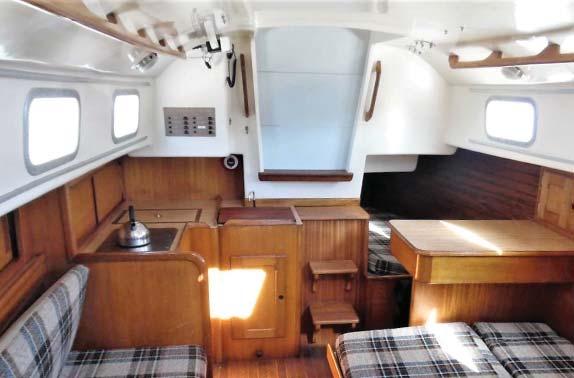
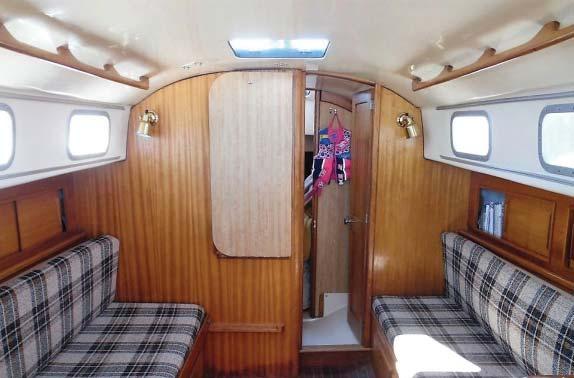
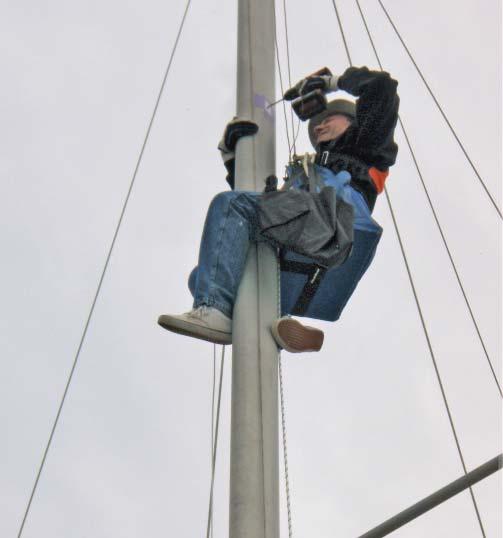
Kenny clinging for dear life while drilling holes to run Lazy Jack lines. Rhonda made it all the way to the top (and wasn't nearly as concerned!).
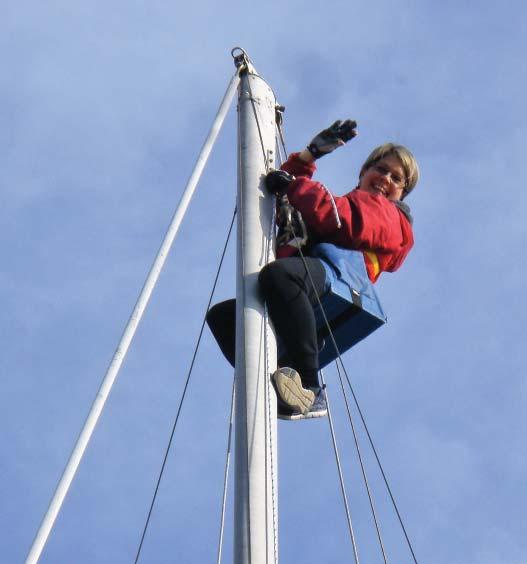
working with them and giving them sailing lessons. The Thayers look forward to sailing with them and learning more. Rhonda understands the importance of being able to handle the boat by herself in case anything were to happen to Kenny while they’re underway, and Kenny’s objective is to be profi cient enough to sail the boat into a slip without the motor. They also realize that learning to maneuver the boat skillfully in our extreme tides and currents will prepare them to handle nearly any coastal cruising conditions they might encounter. "These are skill sets we're both excited to learn and feel are very important," Rhonda said.
Although Kenny is currently on sabbatical from his sheet metal job, he’ll return to work in a few months so they can rebuild their sailing fund. They’ll continue to spend weekends aboard throughout the winter, improving their sailing and navigation skills and just enjoying time on the boat, but next year they look forward to setting out to explore the larger world. When the weather warms, Kenny and Rhonda plan to head north, sailing up the coast to Maine, Nova Scotia, and even the Hudson Bay.
We’ll look forward to following them on their adventures as they sail the dream!
Questor is a 1978 Bristol 29.9 fi n keel sloop, shown here being hauled out. Questor will be getting a new home port soon: Jekyll Island, Ga.
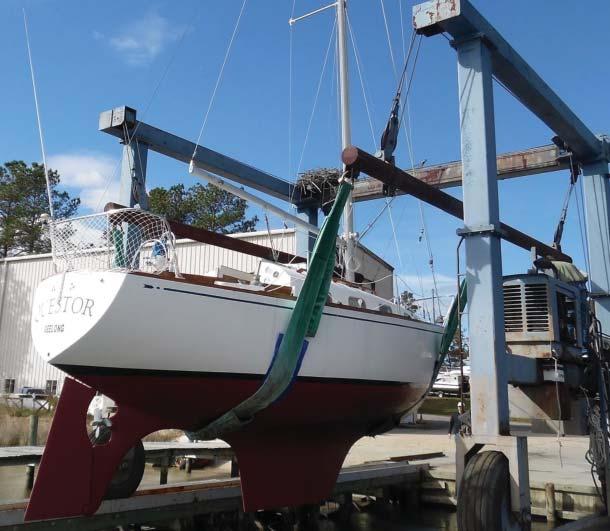
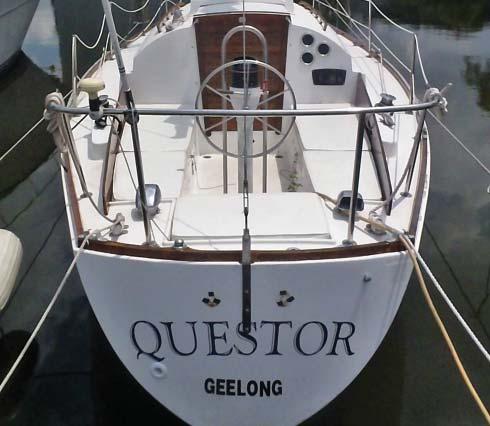
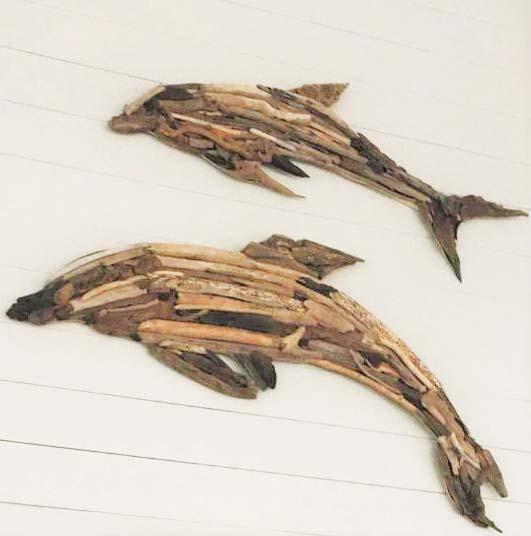
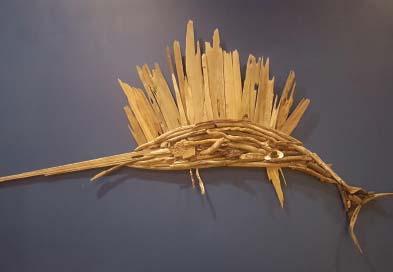
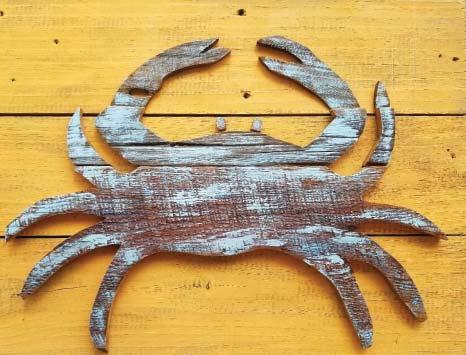
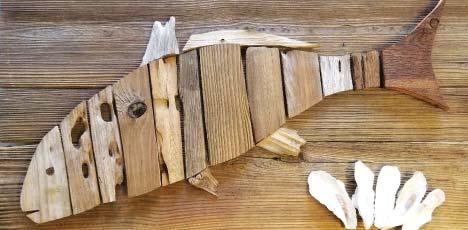
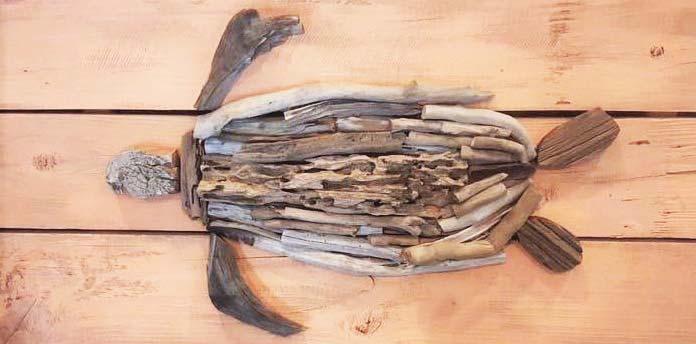
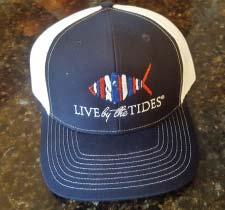
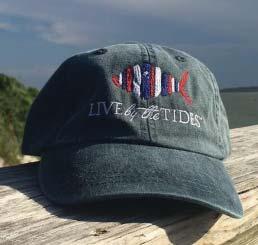
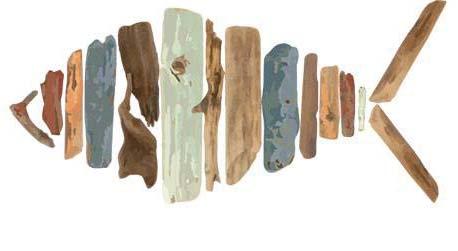

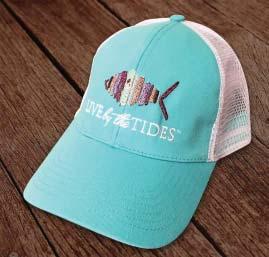
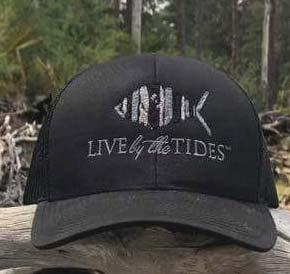
Fiction Spotlight: The Breakthrough Series
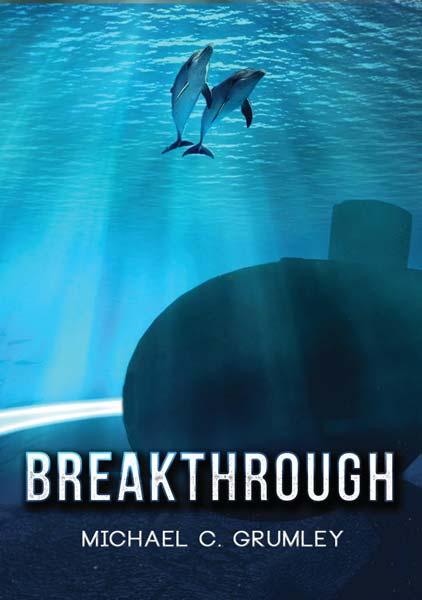
Looking for a good read? Try the Breakthrough series by Michael C. Grumley. Travel along with Naval investigator John Clay, marine biologist Alison Shaw and the dolphins she works with, Dirk and Sally, as they break through communication barriers and in doing so, change the world!

By Amy Thurman
While scrolling through Amazon Kindle listings a few months ago, I came across a novel about dolphins, called Breakthrough, by Michael C. Grumley. It immediately captured my attention because there are just so few stories out there that revolve around the water. It was also part of a series, which meant if I liked it, I’d have several more books to read without having to search.
As it happened, I did enjoy the book and read the whole series. Although the overall story doesn’t specifi cally revolve around the water as I initially assumed, dolphins do play a major role and many scenes are in water settings and on boats.
The series falls somewhere between action/adventure and science fi ction. Plenty of action scenes, some history woven in, some futuristic technology, political maneuverings, low-key romantic involvements, and a story that ties it all together.
Captain Gator is also an avid reader and we frequently talk about what we’re reading, so I referred him to the series. He read all four books as well and also enjoyed them. Gator commented, “Weaving current research and technology together, Michael Grumley is able to blend the elements of an action thriller and science digest and adds a few unexpected sparks!”
We reached out to Grumley and for an interview and he kindly obliged, taking time out from working on the fi fth book in the series to chat with us.
Southern Tides: What initially sparked the idea of a story about communicating with dolphins?
Michael C. Grumley: The idea came to me, maybe fi fteen years ago, after I read a book by Arthur C. Clarke. At the end was a note from the author where he discussed the themes of the book and posited a question, something like: how could humans ever hope to communicate with an alien species some day, if we haven't even learned to speak with the next smartest species on our own planet, which are dolphins.
That got me thinking about how that might actually happen and the concept sat in my head for a good ten years before I fi nally had a story I thought was interesting enough to share.
ST: What interesting research did you do in preparation for writing? Did you get to visit any dolphin facilities?
MCG: I visited some large aquariums and did indeed do some research on dolphins. Unfortunately, at the time there was very little research to be found when it came to actual communication. But there was some. Now, however, there a many teams trying to crack the code, all using slightly diff erent approaches. In fact, a Swedish group is trying to do it with computers and special translation software. Just as it happened in Breakthrough. It makes you wonder where they got the idea!
ST: Although your story is fi ction, are there any aspects of it that mirror reality?
MCG: Yes. There’s a lot of reality in the books. The research, as I mentioned above, how the breakthrough is ultimately achieved in the books, and a lot the physics involved. Not to mention a heck of a lot of the biological elements that are taken from what we currently know in those fi elds.
ST: What prompted you to include a gorilla in the story?
MCG: In the second book, the researchers who achieve the fi rst translation with dolphins then turn their technology to the third intelligent species on our planet which, not surprisingly, are primates. A gorilla was the logical choice, as work like this has already been done in teaching gorillas like Koko sign language at the Gorilla Foundation. In fact, not long after I’d started working on the second book, I received a nice email from a woman named DeeAnn Draper who congratulated me on some aspects of the fi rst book. She then went on to explain that she was a researcher herself at the
MCG: Sure. Defi nitely entertainment. But there are some really big ideas laid out in the Breakthrough books. Ideas that many of us have pondered at some point in our lives, and others that you may not have.
I suppose the underlying theme is about who we are, as humans. Who we are and how much bigger and more "connected" the world might really be than we realize.
ST: Can you give us any clues about book fi ve?
MCG: Well, for anyone who read the fi rst four books, the fi fth is a BIG story. Probably coming in at 600 pages or so. It delves much more deeply into the adventures of our characters, the discoveries that have already been uncovered, and surprises that I don't think any one will see coming.
About the Series
Breakthrough Deep in the Caribbean Sea, a nuclear submarine is forced to suddenly abort its mission under mysterious circumstances. Strange facts begin to emerge that lead naval investigator, John Clay, to a small group of marine biologists who are quietly on the verge of making history.
With the help of a powerful computer system, Alison Shaw and her team are preparing to translate the fi rst two-way conversation with the planet's second smartest species. But the team discovers much more from their dolphins than they ever expected when a secret is revealed on the ocean fl oor. One that was never supposed to be found.
Together, Alison and John must piece together a dangerous puzzle, but time is running out and our understanding of the world is about to change forever.
Leap It was just one year ago that Alison Shaw and her team of marine biologists stunned the world with their incredible breakthrough. And now, they were about to do it again. An ocean away along a lonely coast in South America, an experimental Russian submarine, long thought to have been dismantled, has suddenly resurfaced. And the U.S. Navy has taken notice, sending offi cers John Clay and Steve Caesare to investigate. The sub has been studying a group of unmarked soldiers, disappearing into the jungle each night beneath the cover of darkness. Something has been discovered. Something big, and it's about to fall into the wrong hands. Unless Alison and her team can fi nd something that no one else can.
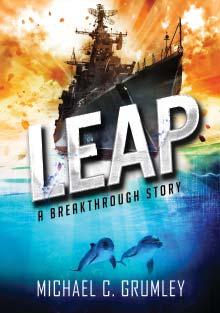
About the Author
For years, Michael C. Grumley dreamed of writing thrillers the way he thought they should be written; complex, multigenre stories with unique plots that 'move'. He lives in Northern California with his wife and two young daughters where he works in the Information Technology fi eld. He's an avid reader, runner and most of all father. He dotes on his girls every chance he gets. He’s currently working on the next novel in the Breakthrough series.
Catalyst In 1984 a doomsday vault was constructed on a remote island in the Arctic Ocean. Its purpose was to preserve Earth’s genetic history in the event of a global catastrophe. Now, decades later, a second vault has been uncovered. But it’s not ours. Even more curious than the vault itself is what lies inside. Seeds. Millions of seeds, each with a genetic embryo untouched and perfectly preserved. Waiting. No one knows who built it, or when. Only that whoever it was traveled an immense distance, for the sole purpose of hiding their genetic blueprints on Earth. But why? Now a small group of marine biologists and navy investigators have been assigned to fi nd out, before anyone else does. But Alison Shaw and John Clay are not prepared for what they are about to uncover, beginning with the truth behind our own evolution.
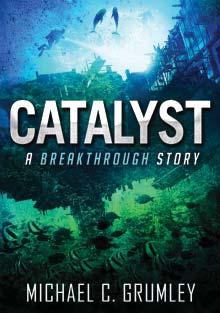
Ripple It began in Ethiopia, hundreds of thousands of years ago. A handful of genetic mutations caused evolution to split from the primates, and mankind was born.
Now, eons later, evidence of more splits from the apes are being unearthed and with them, a disturbing realization. Ours was only one of many.
That we survived was not by luck or chance, but because humans had something other species did not.
First in the mountains of South America, where it was destroyed by the Chinese, and now a second source in Africa, the epicenter of mankind's very inception.
